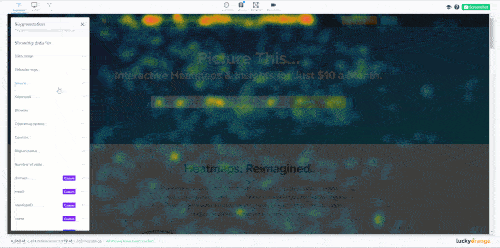Subscribe now and get the latest podcast releases delivered straight to your inbox.
What is Google Analytics? The pros, cons, and ugly missing link

Dec 17, 2019

What is Google Analytics?
Google Analytics is a web-based analytics service that tracks and reports important website data such as traffic, bounce rates, traffic sources, and more.
Google Analytics is a staple for websites, but
Most – if not all – businesses depend on it on some regular basis to understand how their websites are doing. Is traffic up today? How many visitors are bouncing?
It’s popular, handy, filled with data, and free to use --but today’s websites require more insight than just what Google Analytics can muster.
As great as the platform is for businesses, it’s just not enough these days to really dive into what the customers are truly experiencing when they land on your website.
A Brief History of Google Analytics
First, it’s important to understand how Google Analytics came to be the analytic giant it is today.
Back in 1995, Jennifer Aniston rocked “The Rachel” haircut, Amazon sold its first book, cell phones were only used to make calls, and a company called Web Depot, a web consulting and hosting business in San Diego, was founded.
According to Attendly, a few years after it was founded, the company’s CEO and technical guru Paul Muret was developing the first version of Urchin, their analytics software when the classic “a-ha” moment struck.
As Paul explained to Attendly, “One of our large clients was struggling with the fact that it took 24 hours to process a single day’s worth of website tracking results. We tried out our new analytics tool, and it took 15 minutes to process the same data.”
“That’s when the light bulb went off – that Urchin was for real,” he added.
Urchin was a hit, to put it mildly. It quickly became the standard analytic software for thousands of websites.
Fast forward to 2004 and a trade show. Google representatives approached the Urchin team and before they knew it, an offer was on the table and negotiations were underway.
By 2005, the software - Urchin on Demand - was acquired by Google, and with that acquisition, Google Analytics was born.
Within its first week, Google Analytics saw 100,000 new accounts created and by its tenth anniversary in 2015 as many as 30 to 50 million websites used it. !
Let’s take a look at why.
The Good: What Google Analytics Will Do For You
Its history aside, Google Analytics is like the grand-daddy of analytics. It’s a true behemoth of information.
In many ways, diving into Google Analytics feels like Scrooge McDuck diving into his vault of money.
There is just so much information! For example, with Google Analytics you can:
- Create custom reports
- Integrate with other tools (such as Lucky Orange!)
- Show real-time traffic data
- Understand where your traffic came from
- Rank your pages by popularity
- Track campaigns
- Export to Excel
Not only is it powerful, but it’s all something that more people, especially those working within a digital marketing agency, should be learning how to use. Megalytic put it best:
“In a digital agency, web analytics is everyone’s job, whether they realize it or not. [...] You need it for your own insight, but also to help clients to understand their data and how it applies to their businesses.”
How can Google Analytics in particular help agencies? Search Engine Land has a great list of seven reports every marketer should know:
|
Report |
Why |
|
Mobile Performance |
Mobile matters and you know it. In the fourth quarter of 2017, 24% of all digital eCommerce dollars were spent via mobile devices. Understanding how a client’s site performs on the smaller mobile screen is crucial. |
|
Traffic Acquisition |
This report is likely your first step in creating reports. After all, you want to know if an SEO strategy or PPC campaign is working. Traffic Acquisition will give you a breakdown of your traffic sources and referring sources. |
|
Content Efficiency |
You’ll need to be a little more Google Analytic savvy to get this report set up, but it tracks entrances, pageviews, bounces, and goal completions. Click here to learn more from Avinash Kaushik, author of “Web Analytics 2.0.” |
|
Keyword Analysis |
Google has been encrypting search data since 2012, which accounts for about 80% of organic keyword data. However, a lot can still be gained by tracking unencrypted keywords. |
|
New vs. Returning Visitors |
You probably already know that generating traffic isn’t enough these days. New visitors are important, but it’s also necessary to see what percentage of visitors return to your client’s website. Returning visitors are bae. |
|
Landing Pages |
Use this report to see which pages your client’s visitors land on when they first visit the website. If the report shows higher bounce rates on certain web pages, use this information to make these web pages more engaging. |
|
Bounce Rate vs. Exit Rate |
Compare the bounce rate (the percentage of visitor who didn’t take action after viewing just one webpage) with the exit rate (the percentage of visitors who browsed 2+ pages on a website before leaving) to isolate UX problems or find pages with lower engagement. |
Click here to read more from Search Engine Land.
Even if you don’t have a report to prepare for a client, you can still use Google Analytics to answer questions for yourself like:
- How many people are visiting my website?
- Which websites are sending traffic to my website?
- What content/web pages do my visitors like the most?
Click here for a beginner’s guide to Google Analytics from Moz.
Now, it’s a shock to - well - no one that Google Analytics is an essential of websites of all shapes, sizes, and niches -- but that doesn’t mean it should be the only tool in your digital toolbox.
The Bad: What Google Analytics Won’t Do For You
Google Analytics excels in telling you the beginning and end of a visitor’s journey, but the middle gets a little fuzzy.
Sure, it can tell you how many people visited your website, where they left, and even tell you which campaigns were the most successful.
That’s all useful information, but it doesn’t really explain why visitors do what they do.
Many people use Google Analytics to try to uncover this.
Yes, if one page has a high exit rate, it can be assumed that something is wrong with that page, but what? Once again, you may have isolated the problem page, but there’s still much work to be done.
Was it your call-to-action? Was it your not-so-“mobile-friendly” design? Did you just have a broken link? Were they looking for contact information?
The fact is that you cannot really know for an absolute certain if any of these issues were the ultimate cause of the higher exit rate using Google Analytics.
For example: Let’s say you live in this lovely little abode at 742 Evergreen Terrace in Springfield.
You’re hosting an open house and want to know what people are really doing while there.
So, you put a person at each door to count visitors. By doing this, like Google Analytics, you would know roughly how many people entered the door, how many traveled to a different room, how many went upstairs, etc. It could even tell you your most popular rooms.
Unfortunately, it wouldn’t be able to tell you:
- What made your rooms popular;
- Which room was accidentally locked and unable to be accessed; or
- If visitors avoided the living room because the rug had dog poop on it.
It cannot provide you much context or explanation for why visitors did what they did or specifically what they were doing.
Now, let’s say instead you used a tool like Lucky Orange.
Instead of just having a person at the doors counting visitors coming and going, you would now have security cameras in every room feeding real-time video directly to you.
You’ll see everything - where visitors touched, how many kept trying to open a closed door, and what areas of the living room were the most popular.
Furthermore, if you saw someone struggling to find something (say the bathroom), you would be able to chat with
Okay, so the world of websites isn’t quite as homey as the Simpsons’ house. It does offer an excellent illustration of why Google Analytics isn’t enough.
For a website - whether your own or your client’s - you need to know more than just the numbers and charts.
It’s about so much more. We’ll talk more about that in a little bit.
The Ugly Missing Link
Look, I have nothing against Google Analytics. There’s a reason it’s a popular tool, but too many brands make the mistake of only using Google Analytics.
For one, it’s not really “free.”
IMPACT’s Iris Hearn broke down Google Analytics’ “freemium” service in an excellent article here. On the free side, Google Analytics is fine for small businesses that don’t want to pay a monthly charge.
However, those wanting more advanced features or the ability to do more should be prepared to pay up (and I mean pay up).
Google Analytics 360 will cost roughly $150,000 annually in licensing.
Ouch.
You get plenty of additional perks such as emergency 24/7 support and technology recommendations, but with a $150,000 price tag, it’s still a tough upsell to swallow.
In a blink-and-you’ll-miss-it sort of benefit to Google Analytics 360, though, is unsampled reporting.
Sampling is exactly what it sounds like - instead of providing a complete data set, the data is aggregated and delivered in a smaller, bite-sized nugget.
It’s not even unique to website analytics. If you’ve ever been called to take part in a research or political poll, you were among a sample size of participants.
For websites, the free version of Google Analytics reports a sample, or percentage of overall traffic, rather than all of the traffic. Let’s say your website had 5 million sessions during a select time period. Instead of showing you 100% of these sessions, Google Analytics shows you 400,000 sessions or 8% of the total.
In this Supermetrics article, Ruben Ugarte discussed one of the most obvious issues of this - you can end up jumping to conclusions.
Yes, sampling gave you the faster response, but you’re still missing 92% of the data needed to make an informed decision.
In a data-driven world, this accuracy matters.
So, that being said, What percentage of sampling is an accurate reflection of the complete dataset?
Sayf Sharif with Lunametrics argues that even 50% sampling may not be enough to get an accurate look at data.
“I once described the Google Analytics sample rate as akin to my personal confidence in the data. At 90% sample, I’m 90% confident that the data is close to correct. At 50%, I’m 50% confident. At 1% sample, I’m 1% confident.” Sayf wrote. “I don’t generally base opinions on things when I’m as close to a coin flip in regards to my confidence.”
There are workarounds, but it still doesn’t hide the elephant in the room.
IMPACT’s Kyle Bento asked if Google fails digital marketers and their audience. While it’s not directly related to Google Analytics, one portion, in particular, stood out to me:
“If your business is like IMPACT, however, your job isn’t just to gets clicks. Your job as a marketer is to drive business and you do this by answering the questions of your buyers.”
That’s where Google Analytics fails - it does not and cannot answer all of your buyer’s questions.
It can show you data that can help you guess what your buyers’ questions, but it leaves much open to interpretation.
As good and mighty as Google Analytics may be, it can’t do everything. No matter how hard you try, at some point, you have to go beyond the data.
Light at the End of the Analytic Tunnel
Google Analytics isn’t a necessary evil, but it’s not enough for your website. You need more than just data, especially sampled data.
Brian Massey with Conversion Sciences said it best in 2013:
“The ability to make decisions based on data is powerful. In five years, marketers will be prized for their insight, not their creativity.”
Now it’s time to not only ask what insight you need to grow your website but also how you will get said insight. If Google Analytics isn’t the answer, what is?
The light at the end of this analytic tunnel is simple - conversion optimization tools.
I know “conversion optimization” can seem exotic, expensive, and difficult to use, but really it is just tools such as visitor recordings, live chat, form analytics, and polls (to name a few).
These tools complement Google Analytics data in the best way possible. In many ways, it makes data come alive to answer the questions you have about your website and visitors.
Here are three ways conversion optimization tools, in particular, can make a difference with your website.
1. They Measure interactions
As I mentioned in the Simpson house illustration, Google Analytics really fails at detailing what someone does on your website.
You need to see it in action.
For example, a dynamic heat map can help show you where visitors are clicking. You can see where visitors are clicking in a drop-down or which elements are being ignored.

You can also segment the dynamic heat map to show just Facebook traffic or PPC traffic to isolate issues with your campaign or landing page:
As you adjust the “segments” to filter through your data, you can see traffic instantly populate to the filter. You may find that Facebook traffic tends to prefer to stick only above the fold while direct traffic is more likely to scroll to the bottom.
You can then follow up with visitor recordings to see what exactly is going on before and after they clicked on a specific call-to-action.
Pair this insight with a conversion funnel, and all of a sudden you have a new way to look at you or your clients’ visitors and how they are really interacting.
Since nothing is sampled, you get a full look at all interactions and understand where (and why) they left.
2. They Can Connect with Visitors
Google Analytics wouldn’t necessarily be able to tell you which visitor on your client’s website right now is struggling, but tools like Lucky Orange can.
For example, a check of the live visitor recordings would easily let you watch someone interacting right now on your website or on a client’s website.
You could then “ask to chat” to pop up a chat to stop visitors from leaving in real-time by leading them to the right product page or information.
You can also take it a step further by creating a poll that will engage visitors to give their opinion on visitor sentiment, find out what is driving them nuts, identify what visitors are really thinking, and even capture leads.
3. Get Unbiased Feedback
As much as we would like to think that Google Analytics data is absolute, it’s not. We’ve already talked about data sampling, but there’s one other aspect that can hurt websites - biased reporting of Google Analytics data.
Perhaps marketers or designers may misinterpret Google Analytics, other times, it may be that we skew data to meet our own bias expectations. Whatever the reason, ignoring performance issues can only hurt brands by preventing them from understanding what’s working and what’s not.
The answer lies in conversion optimization insight which can’t be manipulated or misinterpreted.
For example, take TaylorMade, one of the leading makers of golf products and accessories. Even though millions of people flock to TaylorMade.com on a monthly basis to get the latest products, tips, and golf news, TaylorMade’s design team struggled.
They were discovering issues too late and becoming reactive. After some deliberation, the team used Lucky Orange dynamic heat maps to see exactly where visitors were clicking on the website before and after designs were implemented.
Clicks don’t lie. Recordings can’t be twisted.
Whether or not changes were effective, dynamic heatmaps and recordings would quickly show what visitors are doing instead.
Maybe it’s not even your changes that went wrong. Was a form field error tripping them up? Maybe they don’t want to be contacted by phone?
Run form analytics to see if there’s something wrong with your forms that could be sending visitors away.
Added bonus: You don’t need to spend $150,000.
Warning: Shameless plug ahead.
If you want to pay $150,000 for Google Analytics 360, by all means, go for it, but there are cheaper methods that can show you more dynamic data - such as Lucky Orange - that start as low as $10 per month.
Not only is it more budget-friendly, but Lucky Orange also integrates with HubSpot. When integrated within HubSpot, recordings, dynamic heat maps, and chat logs are automatically loaded directly for each contact.
And, to put the cherry on top, we also have integrations with Adobe DTM, Magento, Shopify, Unbounce, and a host of other options.
The Bottom Line
Google Analytics belongs in your digital toolbox, but it shouldn’t be the sole tool used on your website or for your clients’ websites.
Conversion optimization insight from tools like Lucky Orange used in conjunction with data tools like Google Analytics can open new doors to improve conversions, impress clients, and make the digital world a better place for all.
Featured Image Created Using Placeit.net


Order Your Copy of Marcus Sheridan's New Book — Endless Customers!
